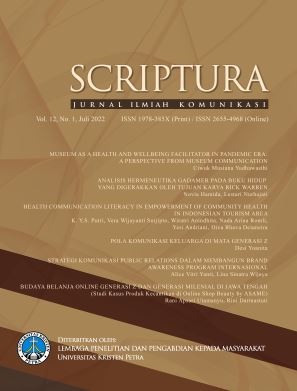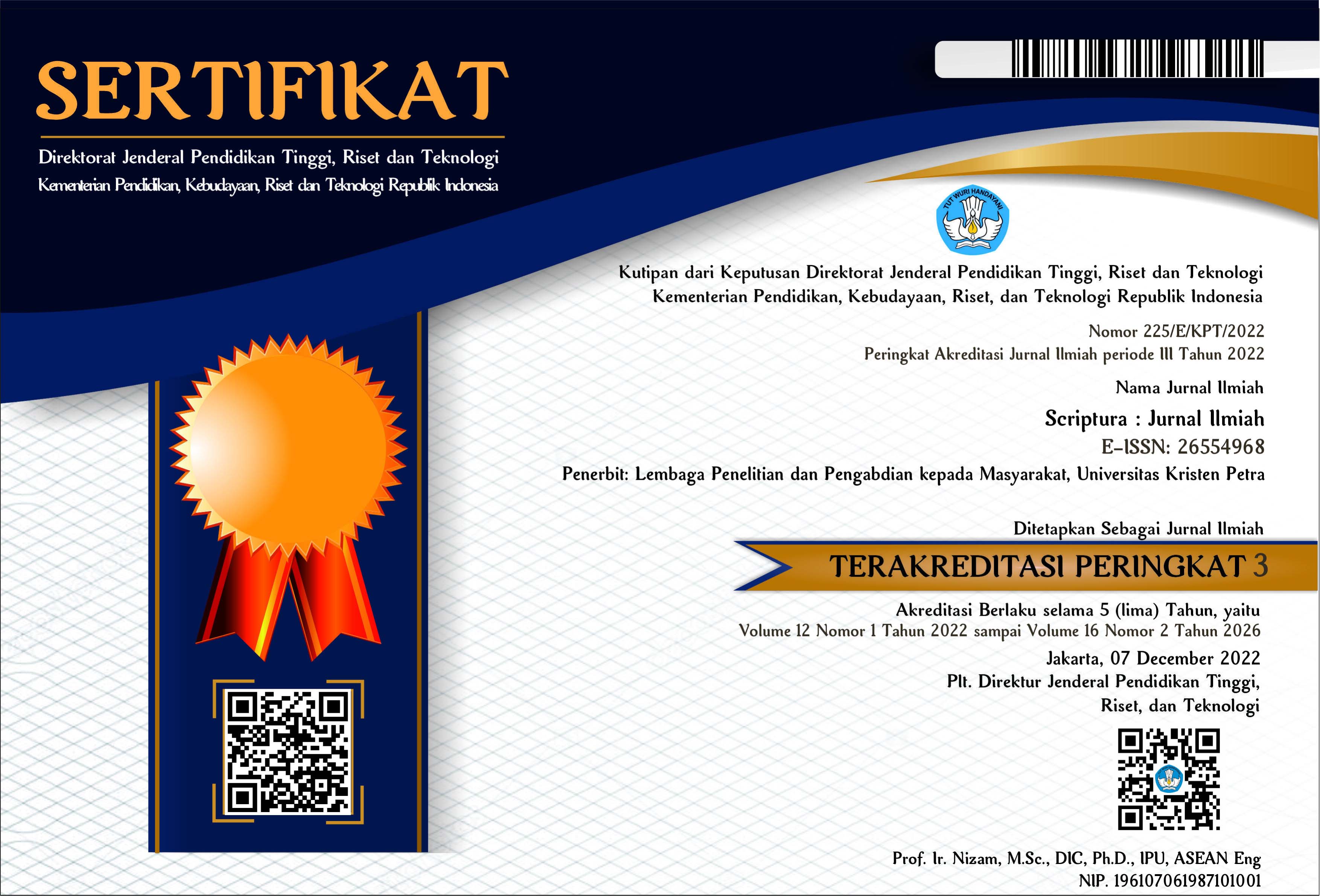POLA KOMUNIKASI KELUARGA DI MATA GENERASI Z
 :
:
https://doi.org/10.9744/scriptura.12.1.33-442
Keywords:
Pola Komunikasi Keluarga, komunikasi orang tua–anak, komunikasi keluarga, Gen ZAbstract
Relasi orang tua dan anak yang menginjak usia dewasa muda (Gen Z) bisa digambarkan sebagai ‘love and hate relationship’. Ketegangan muncul karena di usia tersebut anak sudah memiliki kesadaran akan kemandirian, sementara orang tua masih menjalankan otoritas penuh atas mereka. Pola Komunikasi Keluarga menggambarkan relasi orang tua dan anak dalam dua bentuk, yaitu conformity orientation dan conversation orientation. Penelitian ini mendeskripsikan bagaimana pola komunikasi diterapkan dalam keluarga 10 informan yang berusia 18-25 tahun. Menggunakan metode studi kasus, Peneliti menganalisis data hasil Focus Group Discussion (FGD) secara tematik dan menghasilkan temuan sebagai berikut: 1) kebersamaan dalam keluarga memerlukan komitmen; 2) setiap keluarga memiliki batasan keterbukaan yang berbeda dan keterbukaan tidak selalu terjadi dua arah; 3) orang tua masih berotoritas atas isu jangka panjang atau yang membutuhkan dana besar; 4) memperlakukan anak sebagai orang dewasa merupakan wujud trust dan penghargaan orang tua; 5) relasi antara orang tua menjadi role model kehangatan dalam keluarga; 6) Ayah menjadi sosok penting dalam menciptakan kehangatan.
References
Aggarwal, M., Rawat, M. S., Singh, S., Srivastava, S., & Gauba, P. (2017). Generation Gap: An Emerging Issue of Society. International Journal of Engineering Technology Science and Research, 4(9), 973–983. researchgate.net/publication/320 183778973_Generation_Gap_An_Emerging_Issue_of_Society
Baiocchi-Wagner, E. A., & Talley, A. E. (2013). The role of family communication in individual health attitudes and behaviors concerning diet and physical activity. Health Communication, 28(2), 193–205. https://doi.org/https://doi.org/ 10.1080/10410236.2012.674911
Braun, V., & Clarke, V. (2006). Using thematic analysis in psychology. Qualitative Research in Psychology, 3(2), 77–101. https://doi.org/ http://dx.doi.org/10.1191/1478088706qp063oa
Buckingham, D., & Willett, R. (2006). Digital generations: Children, young people, and the new media (1st ed). Routledge. https://doi.org/ https://doi.org/10.4324/9780203810668
Cabrera, N. J., Fitzgerald, H. E., Bradley, R. H., & Roggman, L. (2014). The Ecology of Father-Child Relationships: An Expanded Model. Jour-nal of Family Theory & Review, 6, 336–354. https://doi.org/10.1111/jftr.12054
Celik, H. (2019). The Mediator Roles of Mothers in Father-Child Communications and Family Relationships. Eurasian Journal of Educational Research, 84, 135–158. https://doi.org/10. 14689/ejer.2019.84.7
Dimock, M. (2019). Defining generations: Where Millennials end and Generation Z begins. Pew Research Center. https://www.pewresearch.org/ fact-tank/2019/01/17/where-millennials-end-and-generation-z-begins/
Doherty, W. J., & Beaton, J. M. (2004). Mothers and Fathers Parenting Together. In A. L. Vangelisti (Ed.), Handbook of Family Communication (pp. 269–286). Lawrence Erlbaum Associates, Inc.
Francis, T., & Hoefel, F. (2018). True Gen: Gene-ration Z and Its Implications for Companies. McKinsey&Company.
Galvin, K. M., Braithwaite, D. O., & Bylund, C. L. (2015). Family Communication: Cohesion and Change (Ninth Edit). Routledge.
Graham, E. (2009). Revised Family Communication Patterns Instrument (RFCP). In Communication Research Measures II. Taylor and Francis.
Gupta, S., & Geetika. (2019). Family Communication Patterns Questionnaire: Development and Vali-dation. International Journal of Recent Technology and Engineering, 8(1), 542–550.
Gutfreund, J. (2016). Move over, Millennials: Generation Z is changing the consumer landscape. Journal of Brand Strategy, 5(3), 245–249. https://www.henrystewartpublications.com/sites/default/files/JBSv5i3Move over Millennials Generation Z is changing the consumer land-scape.pdf
Hastasari, C., Aw, S., & Hajaroh, M. (2018). Family’s Communication Pattern In Preventing Student’s Violence In Yogyakarta. Informasi: Kajian Ilmu Komunikasi, 48(2), 155–168. https://doi.org/https://doi.org/10.21831/informasi.v48i2.22389
Hennink, M. M. (2014). Focus Group Discussion: Understanding Qualitative Research. Oxford University Press.
Hesse, C., Rauscher, E. A., Goodman, R. B., & Couvrette, M. A. (2017). Reconceptualizing the Role of Conformity Behaviors in Family Communication Patterns Theory. Journal of Family Communication, 17(4). https://doi.org/ https://doi.org/10.1080/15267431.2017.1347568
Jamison, T. B., & Lo, H. Y. (2020). Exploring parents’ ongoing role in romantic development: Insights from young adults. Journal of Social and Personal Relationships, 38(1), 84–102. https://doi.org/https://doi.org/10.1177/0265407520958475
Janssen, L. H. C., Verkuil, B., Houtum, L. A. E. M. van, Wever, M. C. M., & Elzinga, B. M. (2021). Perceptions of Parenting in Daily Life: Adolescent-Parent Differences and Associations with Adolescent Affect. Journal of Youth and Adolescence, 50, 2427–2443.
Karlsena, M.-M. W., Gabrielsena, A. K., Falcha, A. L., & Stubberud, D.-G. (2017). Intensive care nursing students’ perceptions of simulation for learning confirming communication skills: A descriptive qualitative study. Intensive and Criti-cal Care Nursing, 42, 97–104. https://doi.org/http://dx.doi.org/10.1016/j.iccn.2017.04.005
Kaufman, P. (2016). Quick chart: What Gen-Z & Millennials really want in life. Collage Group. www.collagegroup.com/2016/09/19/gen-z-millennials-values/
Koerner, A. S., & Fitzpatrick, M. A. (2006). Family Communication Patterns Theory: A Social Cognitive Approach. In D. O. Braithwaite & L. A. Baxter (Eds.), Engaging theories in family communication: Multiple perspectives (pp. 50–65). Sage Publications, Inc. https://doi.org/ https://doi.org/10.4135/9781452204420.n4
Koerner, A. S., Schrodt, P., & Fitzpatrick, M. A. (2017). Family communication: Patterns theory a grand theory of family communication. In Engaging Theories in Family Communication: Multiple Perspectives (pp. 142–153). Taylor and Francis. https://doi.org/https://doi.org/10.4324/ 9781315204321
Kuhar, M., & Reiter, H. (2013). Towards a Concept of Parental Authority in Adolescence. Center for Educational Policy Studies Journal, 3(2), 135–155. https://doi.org/10.26529/cepsj.243
Laursen, B., & Collins, W. A. (2004). Parent-Child Communication During Adolescense. In A. L. Vangelisti (Ed.), Handbook of Family Commu-nication (pp. 333–348). Lawrence Erlbaum Associates, Inc.
Ledbetter, A. M., & Beck, S. J. (2014). A Theoretical Comparison of Relational Maintenance and Closeness as Mediators of Family Communi-cation Patterns in Parent-Child Relationships. Journal of Family Communication, 14(3), 230–252. https://doi.org/https://doi.org/10.1080/1526 7431.2014.908196
LePoire, B. A. (2006). Family Communication: Nurturing and Control in a Changing World. Sage Publications, Inc.
Lynne, K., Keaten, J. A., Finch, C., Duarte, I. B., Hoffman, P., & Michels, M. M. (2002). Family Communication Patterns and the Development of Reticence. Communication Education, 51(2), 202–209.
McGoldrick, M., Garcia-Preto, N., & Carter, B. (2016). The Expanding Family Life Cycle: Individual, Family, and Social Perspectives (5th ed.). Pearson Education, Inc.
Oerther, S. E., & Oerther, D. B. (2021). Review of Recent Research about Parenting Generation Z Pre-Teen Children. Western Journal of Nursing Research, 43(1), 1–14. https://doi.org/10.1177/0193945920988782
Pramono, F., Lubis, D. P., Puspitawati, H., & Susanto, D. (2017). Communication Pattern and Family Typology of High School Adolescents in Bogor - West Java. Jurnal Komunikasi ISKI, 2(1), 20–26. http://jurnal-iski.or.id/index.php/ jkiski/article/view/85/pdf
Rakhmah, D. N. (2021). Gen Z Dominan, Apa Maknanya bagi Pendidikan Kita? Pusat Standar Dan Kebijakan Pendidikan. https://puslitjakdikbud.kemdikbud.go.id/produk/artikel/detail/3133/gen-z-dominan-apa-maknanya-bagi-pendidikan-kita
Rizky, J., & Santoso, M. B. (2018). Faktor Pendorong Ibu Bekerja Sebagai K3l Unpad. Prosiding Penelitian & Pengabdian Kepada Masyarakat, 5(2), 158–164.
Seemiller, C., & Grace, M. (2017). Generation Z: Educating and Engaging the Next Generation of Students. About Campus, 22(3), 21–26. https://doi.org/https://doi.org/10.1002/abc.21293
Seemiller, C., & Grace, M. (2019a). Gen Z: A Century in the Making. Routledge.
Seemiller, C., & Grace, M. (2019b). Generation Z: A Century in the Making. Routledge.
Segrin, C., & Flora, J. (2005). Family Communication. Lawrence Erlbaum Associates, Inc.
Sillars, A., Holman, A. J., Richards, A., Jacobs, K. A., Koerner, A. S., & Reynolds-Dyk, A. (2014). Conversation and Conformity Orientations as Predictors of Observed Conflict Tactics in Parent-Adolescent Discussions. Journal of Family Communication, 14(1), 16–31. https://doi.org/ http://dx.doi.org/10.1080/15267431.2013.857327
Stafford, L., & Bayer, C. L. (1993). Interaction Bet-ween Parents and Children. Sage Publications, Inc.
Swanzen, R. (2018). Facing the Generation Chasm: The Parenting and Teaching of Generations Y and Z. International Journal of Child, Youth and Family Studies, 9(2), 125–150. https://doi.org/10.18357/ijcyfs92201818216
Tabak, I., Mazur, J., Alcón, M. del C. G., Örkenyi, Á., Zaborskis, A., Aasvee, K., & Moreno, C. (2012). Examining Trends in Parent-Child Communication in Europe Over 12 Years. Journal of Early Adolescence, 12(1), 26–54. https://doi.org/10.1177/0272431611419509
Tims, A. R., & Masland, J. L. (1985). Measurement of Family Communication Patterns. Communication Research, 12(1), 35–57.
Wisniewski, P., Xu, H., Rosson, M. B., & Carroll, J. M. (2017). Parents Just Don’t Understand: Why Teens Don’t Talk to Parents about Their Online Risk Experiences. Proceedings of the 2017 ACM Conference on Computer Supported Cooperative Work and Social Computing, 523–540. https://doi.org/https://doi.org/10.1145/2998 181.2998236
Xiao, Z., Li, X., & Stanton, B. (2011). Perceptions of parent-adolescent communication within fami-lies: It is a matter of perspective. Psychology, Health & Medicine, 16(1), 53–65. https://doi. org/10.1080/13548506.2010.521563
Yin, R. (2018). Case Study Research and Applications Sixth Edition. In SAGE Publications. https://doi.org/10.1017/CBO9781107415324.004
Zhao, S. Z., Luk, T. T., Guo, N., Wang, M. P., Lai, A. Y. K., Wong, B. Y. M., Fong, D. Y. T., Chan, S. S. C., & Lam, T. H. (2021). Use of mobile instant messaging chat group is associated with family functioning and well-being: a population-based cross-sectional study. Journal of Medical Internet Research, 23(3). https://doi.org/DOI:10.2196/18876
Downloads
Published
How to Cite
Issue
Section
License
Copyright (c) 2022 Desi Yoanita

This work is licensed under a Creative Commons Attribution 4.0 International License.
Authors who publish in the SCRIPTURA Jurnal Ilmiah agree to the following terms:
Authors retain unrestricted copyright and full publishing rights. The authors grant the Publisher the right of first publication, with the work simultaneously licensed under the terms and conditions of the Creative Commons Attribution License (CC BY) that allows for unlimited use, distribution, and content reproduction on all media as long as the original author and source are properly acknowledged and cited.


















